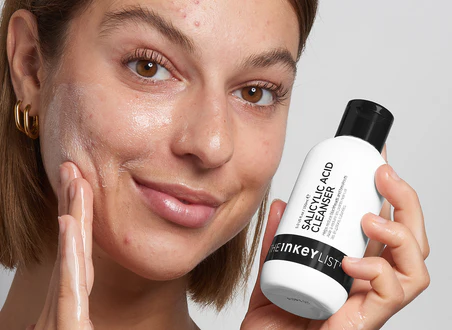
Should I use benzoyl peroxide or salicylic acid first?
If you’ve ever had a bad rash, you’re probably already well aware of what benzoyl peroxide and salicylic acid can do for your skin. But if this is all new to you, you’ve come to the right place, as we’re going to briefly cover both skincare ingredients and explain how best to use them and when to use them in your daily routine.
Benzoyl Peroxide vs. Salicylic Acid – What’s the Main Difference?
Both ingredients have a remarkable ability to prevent rashes and blemishes from forming on your skin. Although it may feel like they target the same areas, benzoyl peroxide and salicylic acid work differently in how they treat your skin and any active breakouts you may have right now.
Salicylic acid helps clear the buildup of dead skin cells that can clog your pores and eventually lead to pimples or blackheads, while benzoyl peroxide kills any bacteria that cause annoying breakouts. Each ingredient is highly effective for treating acne, and both are considered safe enough to be used in conjunction with one another. For example, you could use salicylic acid one night and benzoyl peroxide the next, which is an extremely effective way to treat problem skin. As always, we strongly recommend that you consult with your primary care physician or dermatologist before using high concentrations of these ingredients.
Your acne habits and skin type can also affect the overall appearance of your complexion. Benzoyl peroxide is the ideal ingredient if you notice persistent, active pimples and blackheads on your face. For hormonal breakouts, salicylic acid helps remove dead skin cells and maintain skin clarity.
What is Benzoyl Peroxide?
Benzoyl peroxide, also known as BPO, is an over-the-counter skincare ingredient that kills bacteria on the skin. It is available in different concentrations such as 2.5%, 5%, and 10% and treats those with moderate to severe acne. It also has exfoliating properties that steadily boost skin cell turnover by removing dead skin cells while clearing excess sebum from the pores.
Once you apply benzoyl peroxide to your skin, it fights any lesions on your skin, including blackheads, whiteheads, and active, red pimples. It kills bacteria and reduces the size of zits in a short period of time, allowing you to notice changes in your skin in just five days. Its ability to deliver such impressive, fast results makes sense. But be careful: the right amount of benzoyl peroxide is essential to keep your skin in top condition, as the wrong amount can lead to side effects like dryness, peeling, and redness.
Benefits of Benzoyl Peroxide for Skin Care
Benzoyl peroxide kills all types of bacteria that cause skin blemishes
Benzoyl peroxide helps speed up the turnover of dead skin cells, thus rejuvenating the skin
Benzoyl peroxide is available over the counter in a variety of strengths, which makes it easier for many people to use it because it best suits their skin type and concerns
Benzoyl peroxide works quickly, with results seen within 5 days
Side effects of using benzoyl peroxide
Benzoyl peroxide can cause dryness, redness, and sometimes even peeling of the skin
Benzoyl peroxide can cause fading when it comes in contact with dark fabrics
Benzoyl peroxide is known to cause post-inflammatory hyperpigmentation (dark spots and uneven skin tone).
What should not be used with benzoyl peroxide?
If you use benzoyl peroxide to treat breakouts and blemishes, you should avoid using retinol at the same time, as both ingredients have similar effects on the skin and will cancel each other out, making both useless steps in your skincare routine.
Since benzoyl peroxide is a very effective blemish-fighting ingredient, it has a high chance of causing dryness to the skin. Therefore, it is recommended to combine this antibacterial ingredient with a product that is rich in moisturizing ingredients such as hyaluronic acid. Once you have locked in the skin’s moisture, you also need to consider protecting the skin from environmental stressors, especially UV rays. Applying SPF daily is an important step in your routine use of benzoyl peroxide, as exfoliation can make the skin more sensitive to the sun. SPF 30 and higher protects the skin from any damage.
What is Salicylic Acid?
Salicylic acid is a beta-hydroxy acid, also known as a BHA, that can penetrate into the lower layers of the skin. It can help treat acne and is able to exfoliate the skin and unclog excess sebum, bacteria, and dirt from the pores. You will often find a buildup of dead skin cells on your skin, which is another contributing factor to blemishes. Salicylic acid breaks down the bonds between dead skin cells and the top layer of your face, making it easier to slough off and reveal new, glowing skin underneath.
Similar to benzoyl peroxide, salicylic acid is found in many over-the-counter products in concentrations ranging from 0.5% to 2%. One of the main differences between the two ingredients is that salicylic acid can fight blemishes while soothing the skin, which is a unique advantage of salicylic acid over other acne-fighting ingredients that are known to cause dryness, redness, and irritation. For more information on BHAs, check out our blog post on the skincare benefits of salicylic acid.
Salicylic acid skin care benefits
Salicylic acid exfoliates the skin by removing the buildup of dead skin cells
Salicylic acid shrinks pores
Salicylic acid soothes the skin and reduces inflammation
Salicylic acid is a BHA that can penetrate deeper into the skin layers
Salicylic acid thoroughly cleanses pores of bacteria, excess sebum, and pore-clogging dirt
Side effects of using salicylic acid
Salicylic acid can cause redness, blistering, and rashes if used incorrectly
Unlike benzoyl peroxide, it may take several weeks for salicylic acid to show results
Benzoyl peroxide and salicylic acid are both highly effective ingredients that can effectively combat problematic skin. It doesn’t matter which ingredient you use first, both have impressive benefits and can help you keep your skin clear and fight breakouts with ease. If you incorporate these into a daily regimen that includes many other effective acne-fighting ingredients, you’ll really notice a difference in your complexion. To help you build your anti-acne routine, check out our blog on which ingredients help clear up acne.
Don’t forget to follow us on Instagram for daily skincare tips, product launches, and exclusive discount codes. Don’t miss out on more skincare tips and expert advice on our YouTube channel! Click the Subscribe button to visit our green couch. You won’t regret it!


